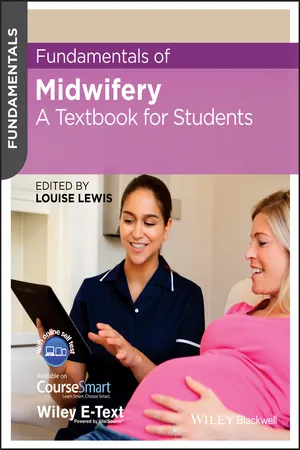
- English
- ePUB (mobile friendly)
- Available on iOS & Android
About This Book
Fundamentals of Midwifery: A Textbook for Students makes the subject of midwifery accessible, informative and motivating, ensuring that it is an essential text for the aspiring midwife!
This resource brings together knowledge from a collection of clinical experts and experienced academics to support your learning and prepare you for the challenges faced in contemporary midwifery healthcare. It presents you with the 'must-have' information that you need concerning both the theoretical and practical aspects of what it means to be a midwife. With extensive full colour illustrations throughout, as well as activities and scenarios, this user-friendly textbook will support you throughout your entire education programme. Fundamentals of Midwifery is essential reading for all pre-registration student midwives, as well as newly qualified midwives.
KEY FEATURES:
• Broad and comprehensive in scope, with chapters on: team working; antenatal care, intrapartum and postnatal care; infant feeding; public health and health promotion; perinatal mental health; complementary therapies; pharmacology and medicines management; and emergencies.
• Interactive and student-friendly in approach, with activities throughout.
• Brings together professional and clinical topics in one user-friendly book.
• Ties in with the latest NMC Standards for pre-registration midwifery education.
• Supported by an online resource centre featuring interactive multiple-choice questions, additional scenarios and activities, and links to further reading.
Frequently asked questions
Information
Chapter 1
To Be a Midwife
Learning Outcomes
- understand how midwifery has evolved as a profession
- examine how midwifery as a profession is regulated in the united kingdom
- identify the support processes available to student midwives undertaking a pre-registration midwifery programme
- be cognisant of the demands working within the midwifery profession
- identify factors that can facilitate successful course completion.
Introduction
Activity 1.1
The Professional Status and Regulation of Midwifery
Box 1.1 Aims of the NMC
- Exist to safeguard the health and wellbeing of the public.
- Set standards of education, training, conduct and performance so that nurses and midwives can deliver high quality healthcare consistently throughout their careers.
- Ensure that nurses and midwives keep their skills and knowledge up to date and uphold the professional standards.
- Have clear and transparent processes to investigate nurses and midwives who fall short of the standards.
The NMC
- The Midwifery Committee.
- Rules as to midwifery practice.
- Local supervision of midwives.
European Union
Table of contents
- Cover
- Table of Contents
- Titles of Related Interest
- Website
- Title page
- Copyright page
- About the Series
- Contributors
- Foreword
- Preface
- Acknowledgements
- How to Use Your Textbook
- About the Companion Website
- Chapter 1: To Be a Midwife
- Chapter 2: Team Working
- Chapter 3: Sociology Applied to Maternity Care
- Chapter 4: Psychology Applied to Maternity Care
- Chapter 5: Parenthood
- Chapter 6: Antenatal midwifery care
- Chapter 7: Intrapartum Midwifery Care
- Chapter 8: Postnatal Midwifery Care
- Chapter 9: Care of the Newborn
- Chapter 10: Infant Feeding
- Chapter 11: Public Health and Health Promotion
- Chapter 12: Contraception and Family Planning
- Chapter 13: Perinatal Mental Health
- Chapter 14: Complementary and Alternative Medicines Applied to Maternity Care
- Chapter 15: Pharmacology and Medicines Management
- Chapter 16: Emergencies in Midwifery
- Chapter 17: Bereavement and Loss
- Answers
- Index
- End User License Agreement